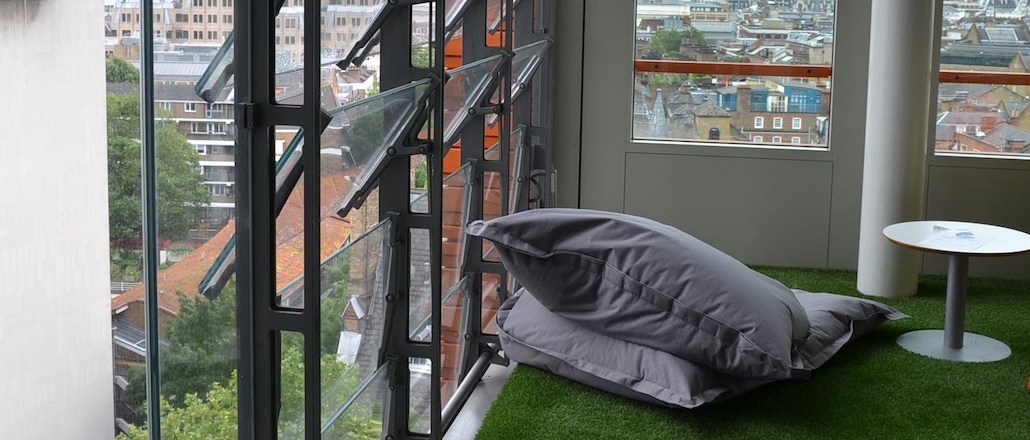
Mindshare’s floor-to-ceiling windows overlook an area that’s in contention for the most polluted in London, as black cabs and double-decker buses cough out diesel fumes below.
The GroupM agency operates in something of an eco haven, though. Since moving into Italian architect Renzo Piano’s mammoth Central Saint Giles development in 2011, Mindshare has made a marked commitment to sustainability. Across its two floors, the 490 employees at Mindshare U.K. and Mindshare Worldwide flush the toilets with the capital’s bountiful supply of rainwater, which is collected from the building’s planted roof terraces.
In the colder months, 80 percent of the office’s heat and hot water comes from bio-mass boilers that run on forestry offcuts from sustainably planted trees. The cafeteria’s coffee cups are all recycled, while staff get a discount for bringing their own mugs. And there are no general trash cans, so staff have no choice but to sort and recycle.

“More companies are thinking about this stuff now,” said Mindshare’s U.K. CEO, Helen McRae. “Ten to 15 years ago, it was niche. Now, it’s odd if you don’t have an environmental policy.”
Cost-cutting is an obvious plus point for an agency this size. “It’s about lots of small things adding up,” McRae said. But as the agency world jostles in the intensifying talent crunch, environmentalism is a differentiator too.
Mindshare is hoping its green ethos can persuade candidates to ditch its rivals. “Environmental credentials are really important for millennials and the people we are trying to recruit,” McRae added.
Ad position: web_incontent_pos1

Next month, Mindshare will host its annual Huddle event, which sees the agency open its doors to a flood of speakers, new-fangled tech and balloon-filled rooms.
This time, its theme is around “good”: what that means for clients and also for the agency itself. This encompasses diversity and social purpose but also what it means to deliver useful experiences for consumers in a challenging media environment.
“Behind every programmatic ad and YouTube video is a human being,” McRae said. “It’s not about a t-shirt following you through the internet but using those tools in a way that delivers human benefit.”

Ad position: web_incontent_pos2
At its “villages,” which are named after oases like Emerald City, staff are never more than 10 meters from a communal area. “We encourage our staff to get out there, to have an opinion and to be starting a debate,” McRae said.
“No one wants to come and work in a morgue. I say to our grads, media is the coolest place to work: It’s constantly changing and never boring. It has to be fun.”


More in Marketing

In the marketing world, anime is following in the footsteps of gaming
As marketers look to take advantage of anime’s entry into the zeitgeist, they might be wise to observe the parallels between the evolution of anime as a marketing channel and the ways brands have learned to better leverage gaming in recent years.

With the introduction of video ads and e-commerce, Roblox looks to attain platform status
Roblox is expanding into more areas than just ads in 2024. Much like platforms such as Amazon and Facebook have transcended their origins to evolve from their origins as online marketplaces and social media channels, Roblox is in the midst of a transformation into a platform for all elements of users’ virtual lives.

PepsiCo wants to remain a ‘driver of culture’ as it turns to influencers and activations amid rebrand
The soda-maker says it can translate cultural relevance into sales volume.
Ad position: web_bfu